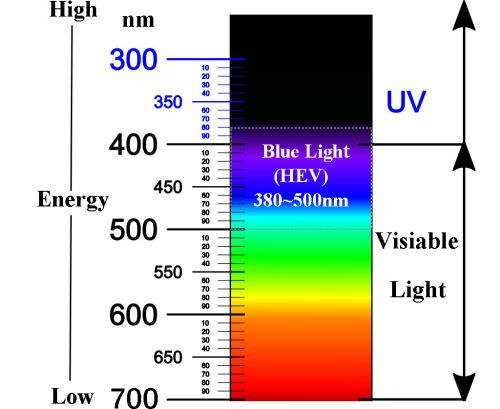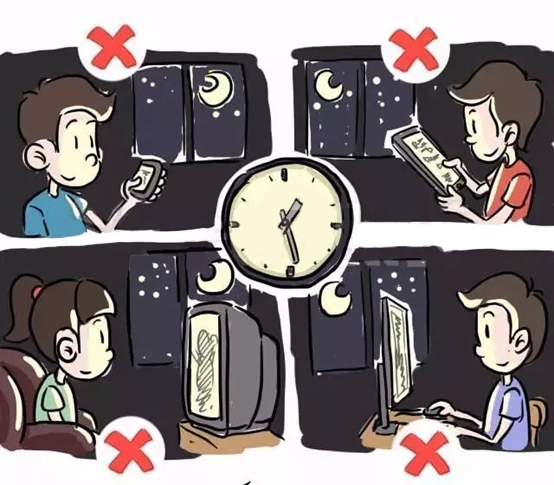All about blue light
Blue light is a type of high-energy light, is part of the visible light spectrum. Natural sunlight contains red, orange, yellow, green, blue, indigo and violet light. Using a prism, you can see how sunlight can be broken up into the spectrum of these colors. And you also can observe these colors in the rainbow.
The different colors correlate with different wavelengths and energy. There is an inverse relationship between the wavelength and the amount of energy of the rays. Lights that have relatively long wavelengths contain less energy, and those with short wavelengths have more energy.
On the light spectrum, you can see different wavelengths, energy and lights. Rays on the bottom have longer wavelength (700nm) and less energy. On the other hand, Rays on the top have shorter wavelength (300nm) and more energy.
What is Blue Light? (HEV)
Blue light is a range of the visible light spectrum that has relatively shorter wavelength (380~500). This short wavelength means that blue light is a type of high-energy visible light. So, these shorter wavelengths and more energy light is considered as high-energy visible (HEV) light or "blue" light.
Blue light (HEV) and UV rays have shorter wavelength than the other lights, which makes them take much more energy and stronger penetration. Although moderate amount of ultraviolet light also has beneficial effects for human body like helping our body synthesize vitamin D; While too much high energy light can cause sunburn on skin and eyes. The specific manifestations of this damage are photokeratitis and macular degeneration.
WHERE IS THE BLUE LIGHT COMING FROM?
Natural sunlight is the main source of all kinds of lights, including the harmful blue light, it balanced the harmful blue light (HEV) with red light. However, we are increasingly surrounded by man-made blue light sources like LED flat screen. Many of todays electronic digital products use LED back light technology to enhance the lightness such as cell phones, computers, tablets and televisions. The LEDs can produce very strong blue light waves.
Following is a spectral distribution map of a LED flat screen. From the distribution map, we can clearly see the LED flat screen emits a high intensity of visible blue light. This is an unbalanced distribution that contains very less red-light, which is very unusual in natural sunlight.
WHAT ARE THE EFFECTS OF BLUE LIGHT ON OUR HEALTH?
First of all, chronic exposure to blue light can lower the production of melatonin, the hormone that regulates sleep, and disrupt your circadian rhythm. It effects our hormonal balance and therefore promotes chronic diseases. In addition, the blue light (HEV) will damage our retina and macular zone, it leads to oxidative stress and other macular degenerations. Many people also suffer from some mild symptoms caused by blue light such as burning, stinging eyes, eye stain, headaches and unsteadiness of vision.
The worst part is our eyes are not good at blocking blue light (HEV).
Human eyes’ structure can help us to block 99% of UV radiation to reach our retina even you are not wearing sunglasses; but unfortunately, unlike UV radiation, our eyes don’t work very well on blocking blue light (HEV). Virtually all visible blue light can pass through our cornea and lens, finally reach our retina easily. That causes eye burning, stinging eyes, eye strain, headaches and unsteadiness of vision after prolonged periods of using digital products like cell phones and computers.
In the digital age, people are surrounded by all kinds of digital products whether they are old and young. Most of us spending our daily time in front of all kinds of screen whether computers or cell phones. Digital eyestrain is a new term used to describe the conditions resulting from the use of today’s electronic products; and the visible blue light is a majority reason causing digital eyestrain. The symptoms of digital eye strain include: eye dry, irritated eyes, blurry vision and difficulty focusing.
Blue light doesn't just affect adults. A study from Kaiser family Foundation shows 74% of teens aged 12-17 access the internet on cell phones, tablets, and other mobile devices at least occasionally and children from ages 8- to 18 spend more than 7 hours a day consuming electronic media.
Solution: Vlook Blue Light protection lenses
Vlook Digital Protection Lenses use special blue cut material and special coating which can efficiently reflect the high energy Blue Light (HEV) emitted by digital devices. This lens has also combined with scratch resistant and anti-glare benefits, giving you clearer vision while using digital devices. These specialized lenses are similar to clear lenses. It does not like the computer glasses which is a yellow tinted lens. Vlook Blue light Protection Lenses will not degrade your visual experience and affect colors.












